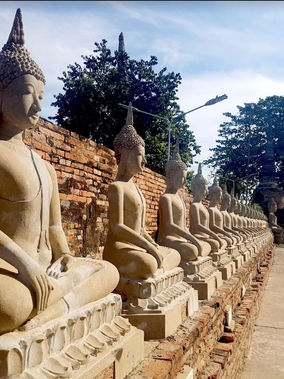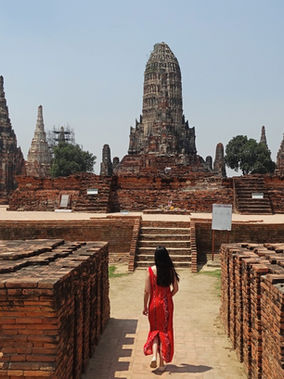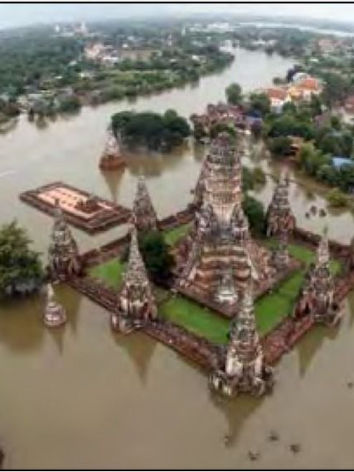

SAVE UNESCO'S
WORLD HERITAGE SITES

The Historic City of Ayutthaya is located in the Phra Nakhon Si Ayutthaya District of Thailand and was initially built in 1350 as the second capital of the Kingdom of Siam. It was once an important centre of world diplomacy and commerce. In 1767, the Burmese army attacked the city and burnt to the ground in the fighting, forcing the inhabitants to abandon their homes and move elsewhere, after which the city was never rebuilt and could not be restored to its original magnificent state. In 1969, Thai officials began renovating the old city, and in 1976 the government set up the area as a historical park, 289 hectares of which were inscribed on the World Heritage List in 1991. Click here to also learn more about Ayutthaya's old dynasties!

The Historic City of Ayutthaya was originally designed as a place close to the bay, relying on water transport for economic development and water transport for cultural development, and the whole city formed a well-developed system of canals that linked all the architectures together. These canals still play an important role today, with transport, excursions and disaster prevention, each of which is important in its function.
Hinayana Buddhism is the main religion of Ayutthaya, has left a large number of temple ruins to this legacy. These ruins not only formed the architectural image by which Ayutthaya is known today, but are also important cultural records and transmitters. Architectural forms, Buddhist images and wall paintings all record the rich and diverse cultural development that characterised Ayutthaya.
Learn more about Ayutthaya's temples here!
Outstanding Universal Value (OUV)
The Historic City of Ayutthaya is located in the Ayutthaya city island of Phra Nakhon Si Ayutthaya District, Phra Nakhon Si Ayutthaya Province. The total area of the World Heritage property is 289 hectares.
According to the Royal Thai Government’s Gazette on the Archaeological Site Designation published on 17 August 1976, the Historic City of Ayutthaya is comprised of 181 archaeological sites, in which 82 sites are visible at present and another 99 sites are mentioned in historic sources but have not yet been found in their present location.


The Historic City of Ayutthaya was inscribed as the World Heritage Site at the 15th Session of the World Heritage Committee at Carthage, Tunisia on 13 December 1991 on the basis of the Criterion (iii): “The Historic City of Ayutthaya bears excellent witness to the period of development of a true national Thai art.”
The designated area of the World Heritage property is covering the most important sites and monuments, including the former Royal Palace, Wat Phra Si Sanphet, Wat Mahathat, Wat Ratchaburana, Wat Phra Ram, Wihan Phra Mongkhon Bophit, Wat Lokaya Sutha, and Wat Thammikarat.
Identification of Threats
The Historic City of Ayutthaya was inscribed on the UNESCO World Heritage List in 1991. It is regarded as having a significant cultural significance for its contributions in shaping Thailand's culture and history with about 400 years in history. However, it was subject to an extreme flooding event in the fall of 2011 as part of the worst flooding which Thailand has experienced in decades.
The cause of the disaster are believed to be a few reasons such as the monsoon, depression of the land, location and most importantly climate change.
However, the result of human-induced activities hves simultaneously also caused threats to the disaster such as unprepared or poor management. The flood hence inevitably has therefore caused a lot of impacts.
For example, the destruction of heritage properties through disasters creates a serious loss for the national and local communities such as museums, temples, archaeological sites, cultural landscapes, and historic landmarks within and around Ayutthaya city.
Meanwhile, it does not only affect the cultural importance of heritage assets but also their socio-economic value.
.png)
Even though there are some mitigation strategies such as the installation of flood prevention systems at some major monuments as well as the constantly revised and updating of the master planning of Ayutthaya City, the risk level causes by floods in Ayuttaha is always high as its proximity does not only occur within world heritage demarcated sites but also districts across the Chao Phraya River Basin with Ayutthaya is located as shown in the figure below. Even though Ayutthaya had the worst flooding event in the fall of 2011, however, due to the vulnerable conditions of its location, the site consistently faced a high frequency of flooding.
We, therefore, consider the risk posed by this event as high based on the likelihood of it occurring frequently and causing irreparable damage when pinned against the framework for threat assessment.
Assessment of Conservation Management Plans
Flood risk prevention and mitigation have been a dominant topic in the conservation of Ayutthaya’s World Heritage site since the 2011 flood. The flood action plan in the latest master plan comprises three sections: “risk assessment”, “flood prevention and mitigation”, and “emergency response”, with a general DRM process of “emergency preparedness, response and recovery”, appearing to be a sound method to control the risk.
Nonetheless, there are defects in the current DRM of Ayutthaya. According to the UNESCO World Heritage Centre, deficiencies of effective management systems and comprehensive management plans have been identified as “factors affecting the property”.

First and foremost, legislations to stipulate archaeological investigations in advance of construction work are still obscure in Ayutthaya, despite it being clear that nearly 55% of the existing and recorded sites are yet to be discovered.
So far, we have not seen any preventive measures to protect these buried sites. The local building control methods only regulate new structures’ size, height, spacing, and appearance while ignoring their impacts on the underground ruins and artefacts. Discoveries of buried heritage are mostly unplanned but by chance, which leads to a risk that contractors deliberately conceal the findings and destroy the evidence.
Secondly, about 90km to the north of the Chao Phraya River estuary, Ayutthaya shares the same aquifer system called “Bangkok aquifer” with the adjacent modern capital city.
The excess groundwater extraction has aggravated the ground subsidence that leads to changes in the physical condition of the topsoil surrounding building foundations.
In Ayutthaya, the sinking ground and the more frequent floods amplify the risk of foundation failure. According to the report submitted to UNESCO in 2016, foundation deformation was a significant threat to the structural safety of the heritage. However, the latest 2021 report mentions neither groundwater nor soil.
Click here for more information on soil mechanics.

Thirdly, a piece of research on climate projects that in the rest of the 21st-century, more intense precipitation will continue to occur in north Thailand, including the catchment areas of the rivers flowing through Ayutthaya.
However, in the reports submitted to UNESCO by the Fine Arts Department, it is unclear what kind of projections or simulation models are used in the flood control plan in Ayutthaya. The current disaster prevention and mitigation methods seem to rely primarily on the experience of the flood events in the past rather than on the future climatic dynamics. Escalating threats from floods intensify risks of damages. For example, moisture in walls accelerates the deterioration of mural paintings.
Suggested Conservation Management Strategies
The first suggested strategy centres around the need to stipulate archaeological evaluation and excavation pre-construction.
Preventive archaeology has been widely adopted across the globe, especially in Europe, to avoid destroying sites of archaeological interests. Still, according to the materials we have collected, there is no hint of such a thing implemented in Ayutthaya. As Thailand's ancient capital, potential archaeological sites are not constrained in the protected areas on the city island. To avoid unnecessary loss of undiscovered heritages, we suggest including pre-construction archaeological evaluation and preventive excavation in Ayutthaya’s urban policies.
Learn more about the preventive archaeology in Europe on the web page of French National Institute for Preventive Archaeological Research.


Secondly, we propose a monitoring system for foundation deformation, groundwater hydrology and geotechnical condition.
In 2016, UNESCO Bangkok recommended “a monitoring system on the impacts of accumulated underground water to the archaeological sites” to be implemented in Ayutthaya. The Fine Art Department carried out a “study of the effect of the tide and of the seasons on the level of three Ayutthaya Rivers and of the type of the sandy alluvial soil” after the 2011 flood. (Anandha, 2016) However, it seems that a long-term program to monitor the foundations, groundwater and geotechnical condition is still absent from the routine management of this World Heritage site, although experts have stressed its necessity.
Find out here how geotechnical engineering can contribute to architectural conservation.
Lastly, there exists a need to study future flood scenarios and alternative conservation methods.
Extreme weather is getting more frequent as the climate changes. There is some likelihood that future floods may exceed the capacity of the current or planned flood prevention and mitigation measures.
Studies of future flood scenarios will facilitate the planning and decision-making of conservation measures. Unlike the local dwelling that can mitigate flood damages by readopting the traditional experience of building houses on stilts, built heritage is much less adaptable to the changing environment since interventions are supposed to be minimized to preserve the authenticity.
To diminish the risks of flood damage and the loss of integrity and authenticity caused by repeated damages and restoration, research on the feasibility of alternative methods (e.g. transferring the vulnerable mural paintings to air-conditioned chambers) is urgently needed.



The End.
Bibliography
UNESCO World Heritage Centre. n.d. “Historic City of Ayutthaya.” UNESCO World Heritage Centre. Accessed November 3, 2021. https://whc.unesco.org/en/list/576/.
“Ayutthaya and Other Flooded Sites.” n.d. World Monuments Fund. Accessed November 3, 2021. https://www.wmf.org/project/ayutthaya-and-other-flooded-sites.
“Several Temples in Thailand’s Historic City of Ayutthaya Underwater after Heavy Monsoon Floods | The Independent.” n.d. Accessed November 3, 2021. https://www.independent.co.uk/climate-change/thailand-ayutthaya-temples-underwater-floods-b1933283.html?jwsource=cl.
‘History of Ayutthaya’. Accessed 22 October 2021. https://ayutthaya-history.com/index.html.
‘Ayutthaya | Map Ayutthaya Historical Park | Suriyothai | Phom Phet Fortress | Siamese Society | Sakdina | Asienreisender’. Accessed 3 November 2021. http://www.asienreisender.de/ayutthaya.html.
Vojinovic, Zoran, Michael Hammond, Daria Golub, Sianee Hirunsalee, Sutat Weesakul, Vorawit Meesuk, Neiler Medina, Arlex Sanchez, Sisira Kumara, and Michael Abbott. “Holistic Approach to Flood Risk Assessment in Areas with Cultural Heritage: A Practical Application in Ayutthaya, Thailand.” Natural Hazards 81, no. 1 (2015): 589–616. https://doi.org/10.1007/s11069-015-2098-7.'
Vojinovic, Zoran, Alida Alves, Jose Patiño Gómez, Sutat Weesakul, Weeraya Keerakamolchai, Vorawit Meesuk, and Arlex Sanchez. “Effectiveness of Small- and Large-Scale Nature-Based Solutions for Flood Mitigation: The Case of Ayutthaya, Thailand.” Science of The Total Environment 789 (2021): 1–15. https://doi.org/10.1016/j.scitotenv.2021.147725.
Anandha, Chuchoti. Thailand’s National Report on State of Conservation: Historic City of Ayutthaya (Thailand) (C576) (Bangkok: Ministry of Culture, Kingdom of Thailand, 2016). Accessed October 17, 2021. https://whc.unesco.org/en/list/576/documents/.
Prateep, Phengtako. Thailand’s National Report on State of Conservation: Historic City of Ayutthaya (Thailand) (C576) (Bangkok: Ministry of Culture, Kingdom of Thailand, 202o). Accessed October 17, 2021. https://whc.unesco.org/en/list/576/documents/.
ICOSMOS. Report on the ICOMOS Advisory Mission to Historic City of Ayutthaya (C576) (ICOSMOS, 2014). Accessed October 17, 2021. https://whc.unesco.org/en/list/576/documents/.
Phoban, Harutus, Uma Seeboonruang, and Prateep Lueprasert. “Numerical Modeling of Single Pile Behaviors Due to Groundwater Level Rising.” Applied Sciences 11, no. 13 (2021): 5782. https://doi.org/10.3390/app11135782.
Masud, Mohammad Badrul, Peeyush Soni, Sangam Shrestha, and Nitin K. Tripathi. “Changes in Climate Extremes over North Thailand, 1960–2099.” Journal of Climatology 2016 (2016): 1–18. https://doi.org/10.1155/2016/4289454.
Daungthima, Wittaya, and Hokao Kazunori. “Assessing the Flood Impacts and the Cultural Properties Vulnerabilities in Ayutthaya, Thailand.” Procedia Environmental Sciences 17 (2013): 739–48. https://doi.org/10.1016/j.proenv.2013.02.091.
Ng, Serene. “Governance beyond the Government: Responding to a Reactionary Flood Governance Regime in Ayutthaya, Thailand.” Habitat International 52 (2016): 11–19. https://doi.org/10.1016/j.habitatint.2015.08.029.









